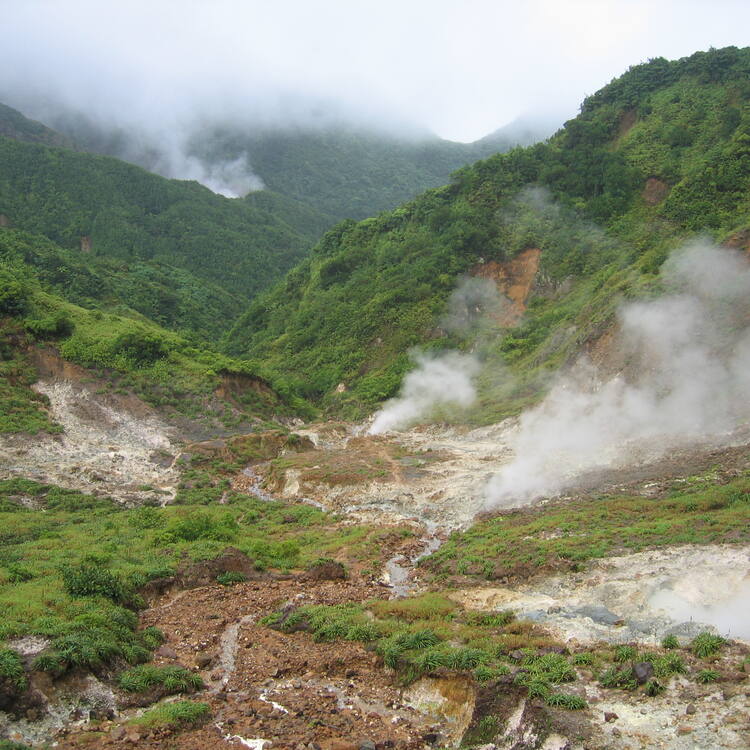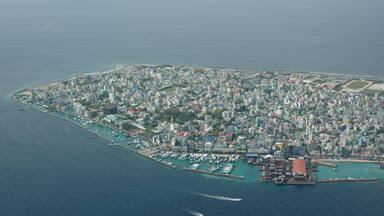Morne Trois Pitons National Park
Morne Trois Pitons National Park
Luxuriant natural tropical forest blends with scenic volcanic features of great scientific interest in this national park centred on the 1,342-m-high volcano known as Morne Trois Pitons. With its precipitous slopes and deeply incised valleys, 50 fumaroles, hot springs, three freshwater lakes, a 'boiling lake' and five volcanoes, located on the park's nearly 7,000 ha, together with the richest biodiversity in the Lesser Antilles, Morne Trois Pitons National Park presents a rare combination of natural features of World Heritage value.
Description is available under license CC-BY-SA IGO 3.0
Parc national de Morne Trois Pitons
Une forêt tropicale luxuriante est associée à des caractéristiques volcaniques d'un grand intérêt panoramique et scientifique dans ce parc national centré sur le Morne Trois Pitons, volcan qui culmine à 1 342 m. Avec des pentes escarpées, des vallées étranglées, 50 fumerolles et des sources d'eau chaude, trois lacs d'eau douce, un « lac bouillonnant », cinq volcans répartis sur les 7 000 ha du site et la diversité biologique la plus riche des Petites Antilles, le parc national de Morne Trois Pitons présente une combinaison rare de caractéristiques de patrimoine mondial.
Description is available under license CC-BY-SA IGO 3.0
منتزه مورن تروا بيتون الوطني
ترتبط هذه الغابة الاستوائيّة الوافرة بخصائص بركانيّة ذات أهميّة مشهديّة وعالميّة في هذا المنتزه الوطني المتمحور حول بركان مورن تروا بيتون القائم على ارتفاع 1342 متراً. يزاوج المنتزه الوطني بين العديد من الخصائص التراثيّة العالميّة فهو الغني بمنحدراته المتعرجّة ووديانه الضيقة ومنافذه البخاريّة الخمسين ومنابع مياهه الدافئة وبحيراته من المياه العذبة وعددها ثلاثة و"البحيرة الفائرة" وبراكينه الخمسة الموزّعة على هكتارات الموقع السبعة آلاف وتنوّعه البيولوجي الأغنى لجزر الأنتيل الصغيرة.
source: UNESCO/CPE
Description is available under license CC-BY-SA IGO 3.0
毛恩特鲁瓦皮顿山国家公园
这个国家公园位于海拔1342米的毛恩特鲁瓦皮顿火山区中心,园内丰富的天然热带森林与具有重要科学价值的火山景致交织在一起。特鲁瓦-皮顿山国家公园近7000公顷的园区内自然景观星罗棋布:陡峭的斜坡、幽深的峡谷、50处火山喷气孔、温泉、3处淡水湖、一个“沸腾湖”以及五座火山。这里还有着小安的列斯群岛最丰富的生物物种资源,展现了一幅自然景观与世界遗产价值相融合的奇妙图景。
source: UNESCO/CPE
Description is available under license CC-BY-SA IGO 3.0
Национальный парк Морн-Труа-Питон
Парк, где густые тропические леса сочетаются с живописным вулканическим рельефом, располагается в районе вулкана высотой 1342 м, известного под названием Морн-Труа-Питон. На территории в 7 тыс. га можно увидеть крутые обрывы и глубокие ущелья, 50 фумарол (парогазовые струи), горячие источники, три пресноводных озера, «кипящее озеро» и пять потухших вулканов, а также зафиксировать самое значительное – в пределах Малых Антильских островов – биоразнообразие. Все это свидетельствует об особенной ценности данного объекта всемирного природного наследия.
source: UNESCO/CPE
Description is available under license CC-BY-SA IGO 3.0
Parque nacional de Morne Trois Pitons
Los exuberantes bosques tropicales y las formaciones volcánicas de este parque nacional que tiene por centro el Morne Trois Pitons, un volcán de 1.342 m. de altura, le confieren un gran atractivo paisajístico y científico Con escarpadas pendientes, valles angostos, cincuenta fumarolas y fuentes de agua caliente, tres lagos de agua dulce, un “lago efervescente”, cinco volcanes esparcidos por las 7.000 hectáreas del sitio y la biodiversidad más rica de las Pequeñas Antillas, el parque posee un conjunto excepcional de características naturales que hacen de él un valioso sitio del Patrimonio Mundial.
source: UNESCO/CPE
Description is available under license CC-BY-SA IGO 3.0
モーン・トロワ・ピトンズ国立公園
source: NFUAJ
Nationaal park Morne Trois Pitons
Source: unesco.nl
Outstanding Universal Value
Brief Synthesis
A rugged mountain range featuring steep volcanoes and deep canyons forms the natural spine of Dominica, a volcanic island of the Lesser Antilles. Morne Trois Pitons National Park (MTPNP) protects a scenically striking part in the central and southern highlands with an extension of 6,857 hectares, roughly 9 percent of the country’s land area. The centerpiece is Morne Trois Pitons, one of five live volcanic centers within the park. Above 1,300 m.a.s.l., this spectacular dome complex is the highest peak within the property. The park’s landscape is dominated by the extreme relief covered by various types of tropical forest against the dramatic backdrop of diverse volcanic topography and features. The scenic beauty is further complemented by numerous natural lakes and pools, including Boeri Lake and Freshwater Lake, the country’s largest lakes. Countless rivers and creeks originate in MTPNP, often forming magnificent waterfalls on their way towards the ocean.
Within MTPNP there are massive volcanic piles surrounded by precipitous glacis slopes and soufrieres, in particular the Grand Soufriere or Valley of Desolation. In this large amphitheater-like area surrounded by mountains, the volcanic activity is displayed in the form of streams of various colors interspersed with fumaroles and hot springs, bubbling mud ponds and the aptly named Boiling Lake. The latter is a massive hot spring with a water temperature of about 95°C. Surrounded by steep cliffs, the lake is one of the largest of its kind in the world. It constantly bubbles and churns, with steam emitting an almost surreal sound. Water level and coloration vary greatly.
The barren vegetation in the Valley of Desolation contrasts sharply with the lush vegetation dominating the landscape elsewhere. The rugged and abrupt relief results in a highly varied mosaic of vegetation and habitats. At least five forest types can be distinguished, including rare Elfin or cloud forest at the highest elevations. Overall, the forests are in a remarkably good conservation state within a region that has otherwise lost most of its historic forest cover. MTPNP is known for its rich, partially endemic flora and remarkable fauna. The property boasts major freshwater resources, including the headwaters of the streams and rivers in the southern half of the island.
Criterion (viii): The property encompasses extraordinary and intact examples and arrays of geomorphologic features as a result of a series of volcanic eruptions. The distinctive geology and landforms of Morne Trois Pitons National Park are comprised of three major types of geological formations: volcanic piles, glacis slopes and soufrieres. The property displays a magnificent spectrum of volcanic activity in the form of streams of various colors interspersed with fumaroles, mud ponds and hot springs, including the massive Boiling Lake. Ongoing geo-morphological processes of reduction are taking place in a largely undisturbed setting of stunning scenic value and major scientific interest.
Criterion (x): Morne Trois Pitons National Park is home to one of the very rare largely intact forest areas remaining in the Insular Caribbean, a region recognized through various priority-setting exercises as a highly threatened biodiversity region and center of endemism of global importance. Along extreme altitudinal and micro-climatic gradients an impressive variety of forest types has evolved featuring a highly diverse flora with many endemic vascular plant species. There are also endemic reptiles and amphibians and a noteworthy number of bird species, including the Imperial Parrot and the vulnerable Red-Necked Parrot, which are endemic to Dominica. Much of the biological wealth remains to be documented and research is likely to reveal further biodiversity secrets.
Integrity
While the property is not very large in absolute terms, it covers a significant area of the relatively small island of Dominica. The boundaries adequately cover the geological and volcanic features and phenomena, and include representative areas of the various tropical forest types. The forests harbor a microcosm of Dominica’s biological diversity and species endemism, and provide intact and protected habitat for a wide diversity of flora and fauna, including a range of endemic species across several taxonomic groups.
Most of the property is in a good state of conservation. There is a high degree of natural protection as a function of the harsh terrain and the lack of road infrastructure in most of the property. While historic land and resource use is poorly documented, there are no human settlements within MTPNP’s boundaries today and there are no major population centers in the immediate vicinity. Minor impacts have included a small quarry, agricultural encroachment in the south of the property and the legally permitted water and power rights granted to Dominica’s Electric Utility Company which have so far been used in a responsible way.
As long as the legal requirements are maintained and de facto enforced, the park’s essential attributes and natural heritage values are not under any immediate threat.
Protection and management requirements
Some historic accounts suggest that the conservation of Dominica’s interior forests may be in part related to the original inhabitants’ fierce resistance to settlements. The formal conservation history of Morne Trois Pitons National Park dates back to the 1950s when the area was first proposed as a forest reserve. MTPNP was designated in 1975 as the country’s first national park under the provisions of the National Parks and Protected Areas Act. The responsibility for the protection and management rests with the Division of Forestry, Wildlife and National Parks of the Ministry of Agriculture and Fisheries. Day to day responsibilities for the MTPNP resides in the National Parks Unit of the Division, headquartered in the nearby capital of Roseau. The development and management of the Morne Trois Pitons National Park is guided by management plans covering periods of several years.
While the property is in a good state of conservation, it is not immune from the many threats and challenges well known in Caribbean island settings. There are a number of invasive alien species, such as opossum and agouti, as well as feral cats, pigs and rats. The impacts are poorly monitored and understood. Consequently, a better understanding is needed. More decisively, MTPNP’s importance for hydropower, geothermal energy and drinking water is reflected in conservation legislation. Corresponding rights have been granted to the governmental electric power provider. Possible further energy development and transmission, as well as use of geothermal energy, are permitted and require a careful balancing between conservation requirements and competing societal demands.
Dominica is susceptible to heavy tropical storms. Major hurricane events occurred for example in 1979 and 1980 resulting in major damage to the forests. Another issue is tourism, which remains localized due to the poor infrastructure. A cable car construction project through the centre of the property was not approved, yet serves as a reminder of the delicate balance between benefits and risks associated with tourism development in protected areas.
In terms of both species conservation and awareness-raising, the Imperial Parrot or Sisserou, the island's national bird featured on the national flag, is of high symbolical value. Some of its key habitat is known to be outside of the park suggesting room for further optimization of the boundaries.
From the very beginning MTPNP has been suffering from funding and staffing shortages and a heavy reliance on external support. Future management will have to ensure that the above described threats can be responded to through the allocation of adequate funding and the consolidation of capacities.

 View photos from OUR PLACE the World Heritage collection
View photos from OUR PLACE the World Heritage collection